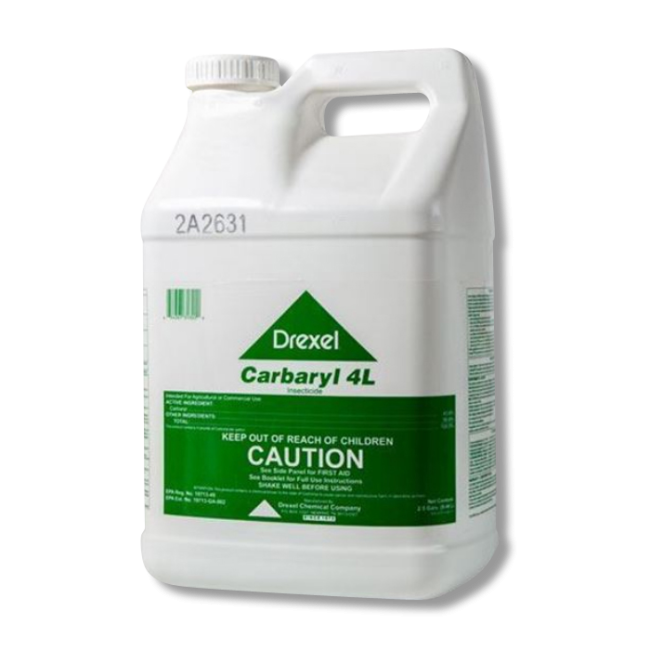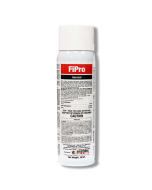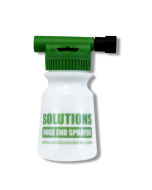Gain access to personalized product screening, the best pricing, rewards, and more!








application2
Carbaryl 4L Insecticide (Sevin)
Carbaryl 4L Insecticide is ideally designed for controlling pests around agricultural sites. It is safe to apply to plants and crops to keep insects off them.
09/21/25
Carbaryl 4L Insecticide Sevin, manufactured by Drexel, is a powerful and cost-effective insecticide application used primarily to treat unwanted pests that like to infest crops and plants.
The Carbaryl 43.4%- based formula delivers a quick knockdown and is safe to use on plants, so you do not have to worry about the chemical damaging your crops, fruits, or agriculture.
Tools Needed
You will need a hose-end sprayer, handheld pump sprayer, backpack sprayer, or spray rig. For smaller residential treatments, we recommend a handheld 1-gallon pump sprayer or a 4-gallon backpack sprayer.
How to Use
- Step 1: Determine how much Carbaryl 4L you will need for your application by measuring the square footage of the treatment area. Find the square footage by measuring the length and width of the treatment area in feet, then multiply them together (length x width = square footage). Carbaryl 4L is mixed at a rate of 0.5 to 3 oz. per gallon of water to treat a 1,000 sq. ft. The specific rate varies depending on the site being treated and the insect being targeted. For example, if you measured 3,000 sq. ft. of turfgrass to treat for ticks, the rate is 0.75 fl. oz. per 1,000 sq. ft. so that you will need 2.25 fl. oz. of Carbaryl 4L mixed in 3 gallons of water.
- Step 2: Fill your selected sprayer halfway with the required amount of water, then add the correct amount of Carbaryl 4L based on your calculations. Fill the sprayer the rest of the way with the remaining half of the water and close the lid. Agitate the sprayer until the solution is well-mixed, and you are ready to spray.
- Step 3: Apply the product according to the labeled directions in the areas where you have pest infestations. Completely cover foliage right before the point of runoff. Repeat application as needed to keep pests away.
Where to Use
Carbaryl 4L Insecticide is meant to control pests around crops, trees, and turf outdoors. You can treat areas outside residences, places of business, hospitals, golf courses, and anywhere you have insects that damage outdoor plants.
When to Use
Use this product if you recognize a pest infestation in your yard or if you notice turf or tree damage. Pest activity is typically very high during the spring and summer months.
Safety Information
Carbaryl 4L is safe to use around children and pets when applied according to the product label instructions. Always wear the proper personal protective equipment (PPE) when mixing and applying this product.
Do not allow people or pets to enter the treated area until the spray has dried.
Special Considerations
Where a dosage range is indicated for labeled rates, use the lower rate on light to moderate infestations, young plants, and early instars, and use the higher rate on heavy infestations, mature plants, advanced instars, and adults.
| Availability | Online |
| Restricted Use | No |
| Shipping Restrictions | 2.5 Gallon: AK, CA, CT, HI, MI, NY, OR, RI, SC, VT |
| Brand | DREXEL |
| Keith's Pro Tips | "Carbaryl 4L can kill many pests and stop the damage. If you notice your plants or crops are still damaged or discolored after treatment, the problem may be a fungal disease." |
| Product Drawbacks | Staining may occur on certain surfaces such as brick, carpet, cinder block, fabrics ,stucco and wood. Spray deposits on painted or stained surfaces should be removed immediately by washing to prevent discoloration. |
| Target Pests | Alfalfa Blotch Leafminers, Alfalfa Caterpillars, Alfalfa Loopers, Alfalfa Weevil Larvae, Ants, Apache Cicadas, Apopka Weevils, Apple Aphids, Apple Maggots, Apple Mealybugs, Apple Pandemis, Armyworms, Ash Whitedlies, Ashwhitedlies, Asparagus Beetles, Aster Leafhoppers, Avocado Leaf Rollers, Azalea Leafminers, Azalea Leafmoners, Bagworms, Balsam Twig Aphids, Bean Leaf Beetles, Billbugs, Bilster Beetles, Birch Leafminers, Black Cherry Aphids, Black Grass Bugs, Black Margined Aphids, Black Scales, BlackMargined Aphids, Blister Beetles, Blueberry Maggots, Boxelder Bugs, Boxwood Leafminers, Brown Soft Scales, Browntail Mohs, Browntail Moths, Budworms, Calico Scales, California Orangedogs, California Pearslugs, California Red Scales, Cankerworms, Casebearers, Catalpa Sphinx, Catapla Sphinx, Caterpillars, Cereal Rust Mite, Chafer Beetles, Cherry Fruitworms, Cherry Maggos, Chiggers, Chinch Bugs, Citrus Cutworms, Citrus Rust Mites, Citrys Snow Scales, Cloverhead Weevils, Cochineal Scales, Codling Moths, Colorado Potato Beetles, Cooley Spruce Gall Adelgids, Corm Earworms, Corn Earworms, Corn Rootworm Adults, Corn Rootworms, Cowpeacurculios, Cranberry Fruitworms, Cranberry Twig Girdlers, Cucumber Beetles, Cutworms, Cypress Tim Moths, Cypress Tip Moths, Diamondback Moth, Douglas-Fir Tussock Moth, Eastern Spruce Gall Adelgids, Eastern Tent Caterpillars, Egyptian Alfalfa Weevil Larvae, Eightspotted Foresters, Elm Leaf Aphids, Elm Leaf Beetles, Elm Spanworms, Elmleaf Beetles, Eriophyid Mites, Essex Skippers, European Alfalfa Beetles, European Corn Borers, European Crane Flies, European Earwigs, European Fruit Lecaniums, European Pine Shoot Moths, European Raspberry Aphids, Eutopean Fruit Lecaniums, Eyespotted Bud Moths, Eyespotted Bug Moths, Fall Armyworms, Fall Webworms, Filbert Aphids, Filbert Leafrollers, Filbertworms, Flea Beetles, Fleas, Frosted Scales, Fruittree Leafrollers, Fruitworms, Fuchia Gall Mites, Fuchia Gall Mites, Fuller Rose Beetles, Gall Midges, Gall Wasps, Grape Berry Moths, Grape Leaffolders, Grape Leafrollers, Grasshoppers, Green Cloverworms, Green Fruitworms, Greenstrioed Mapleworms, Gypsy Moths, Hackberry Nipple-Miners, Hackberry Nipplegal Makers, Harlequin Bugs, Hickory Shuckworms, Holly Bud Moths, Holly Leafminers, Imported Cabbageworms, Imported Fire Ants, Jackpine Budworms, Japanese Beetles, Jeffery Pine Needleminers, June Beetles, Juner Beetles, Lace Bugs, Leafhoppers, Leafrollers, Lecanium Scales, Lesser Appleeworms, Lesser Beetles, Lesser Peachtree Borers, Lesser Webworms, Limabean Podborers, Little Leaf Notchers, Locust Borers, Lygus Bugs, Maple Leafcutters, Meadow Spittlebugs, Mealy Plum Aphids, Mealybugs, Melonworms, Mexican Bean Beetles, Mexican Been Beetles, Mimosa Webworms, Mormon Crickets, Nantucket Pine Tip, Navel Orangeworms, Oak Leafminers, Oak Moths, Oak Skeletonizers, Oakworm, Oleander Caterpillars, Olive Ash Borers, Omnivorous Leafrollers, Omnivorous Leaftiers, Omnivorus Leaftiers, Orange Tortrix, Orangestriped Oakworms, Oriental Fruit Moths, Painted Ladies, Pea Leaf Weevils, Pea Weevils, Peach Twig Borers, Peach twig Borers, Pear Leaf Blister Mites, Pear Psyllas, Pear Rust Mites, Pecan Leaf Phylloxeras, Pecan Nut, Pecan Nut Casebearers, Pecan Spittlebugs, Pecan Stem Phylloxeras, Pecan Weevils, Peccan Spittlebugs, Periodical Cicadas, Pickleworms, Pine Loopers, Pine Sawflies, Pine Spittlebugs, Pitch Pine Tip Moths, Plant Bugs, Plum Curculios, Poinsettia Hornworms, Potato Leafhoppers, Prune Leafhoppers, Psyllid, Psyllids, Puss Caterpillars, Range Caterpillars, Range Crane Flies, Raspberry Fruitworms, Raspberry Sawflies, Redbanded, Redbanded Leafrollers, Redhumped Oakworms, Rose Aphids, Rose Chafers, Rose Slugs, Rosy Apple Aphids, Saddled Prominents, Saltmarsh, Saltmarsh Caterpillars, San Jose Scales, Sap Beetles, Sawflies, Scale Insects, Skeletonizers, Snowy Tree Crickets, Sod Webworms, Southwestern Corn Borers, Sowugs, Sparganothis, Spiney Elm Caterpillars, Spittlebugs, Spring-tails, Spruce Budworms, Spruce Needle-Miners, Squash Bugs, Starwberry Weevils, Stem Weevils, Stink Bugs, Stinkbugs, Strawberry Bud Weevils, Strawberry Clippers, Strawberry Fruitworms, Strawberry Leafrollers, Strawberry Weevils, Striped Grass Loopers, Subtropical Pine Tip Moths, Suckflies, Sunflower Beetles, Sunflower Moths, Sweet Potato Hornworms, Sweet Potato Weevils, Tadpole Shrimp, Tarnished Plant Bugs, Tent Caterpillars, Tentiform Leafminers, Thornbugs, Three-Concerned Alfalfa Hoppers, Threecorned Alfalfa Hoppers, Thrips, Ticks, Tobacco Flea Beetles, Tomato Fruit Worms, Tomato Hornworms, Tomato Pinworms, Tortoise Beetles, Twig Girdlers, Velvetbean Caterpillars, Walmart Caterpillars, Walnut Caterpillars, Webworms, Western Bean Cutworms, Western Grapeleaf, Western Grapeleaf Skeletonizers, Western Hemlock Loopers, Western Spruce Budworms, Western Tussock Moths, Western Yellowstriped Armyworms, White Apple Leafhoppers, White Grubs, Whitefringed Beetles, Willow Leaf Beetles, Woolly Apple Aphids, Woolly Gall Aphids, Yellow Poplar Weevils, Yellow Scales, Yellowheaded Fireworms, and Yellowstriped Armyworms. For more target pests please refer to the label. |
| Application Equipment | Backpack Sprayer, Hose End Sprayer, Pump Sprayer |
| Application Methods | Broadcast Spray, Spot Treatment |
| Active Ingredient | Carbaryl 43.4% |
| Product Type | Insecticide |
| Formulation | Suspended Concentrate |
| Application Rate | Trees and Ornamental Plants: 1 to 5 qt. per acre or to 100 gallons of water Turf-grass: 1 - 8 qt. per acre. For more specific application rates please refer to the label. |
| Shelf Life | Carbaryl 4L Insecticide Herbicide will last 1 to 2 years in storage if kept in cool, dry place. |
| Yield | A 2.5 Gallon container of Carbaryl 4L can treat about 10 acres when using the moderate 1 quart per acre rate. |
| Use Sites | Outdoors |
| Time to Kill | Carbaryl 4L will kill only pests that are present at the time of application and directly contacted by the product. |
| Comparable Products | Sevin SL |
| EPA Registration # | 19713-49 |
| Restricted Use | No |
|---|---|
| Shipping Restrictions | AK, CT, HI, MI, NY, OR, RI, SC |
| Availability | Online |
| Signal Word | CAUTION |
| Keith's Pro Tip | "Carbaryl 4L can kill many pests and stop the damage. If you notice your plants or crops are still damaged or discolored after treatment, the problem may be a fungal disease." |
| Target Pests Multi | Alfalfa Blotch Leafminer, Alfalfa Caterpillars, Alfalfa Looper, Alfalfa Weevil Larvae, Ants, Apache Cicadas, Apopka Weevil, Apple Aphid, Apple MealyBug, Apple Pandemis, Apple Rust Mites, Armyworms, Ash Whitefly, Asparagus Beetle, Aster Leafhopper, Azalea Leafminer, Bagworms, Balsam Twig Aphid, Bean Leaf Beetle, Bear Tick, Bees, Beet Leaf Beetles, Birch Leafminer, Black Cherry Aphid, Black Grass Bugs, Black Legged Tick, Black Margined Aphid, Black Scale, Black Turfgrass Ataenius Larvae, Blister Beetles, Blueberry Maggot, Bluegrass Billbug Larvae, Bluegrass Weevil Larvae, Boxelder Bugs, Boxwood Leafminers, Brown Dog Ticks, Brown Soft Scales, Brown Tail Moth, Budworms, Calico Scale, California Orangedog, California Red Scale, Cankerworms, Catalpa Sphinx, Centipedes, Cereal Rust Mite Timothy Mite, Chafer Beetle Grubs, Cherry Fruitworms, Cherry Maggots, Chestnut Weevil, Chiggers/Red Bugs, Chinch Bugs, Citrus Cutworm, Citrus Root Weevil, Citrus Rust Mite, Citrus Snow Scales, Cloverhead Weevils, Cochineal Scales, Cockroaches, Codling Moths, Colorado Potato Beetle, Cooley Spruce Gall Adelgid, Corn Earworm, Corn Rootworm, Cowpea Curculios, Cranberry Twig Girdlers, Cranberry_Fruitworms, Crickets, Cucumber Beetles, Cutworms, Cypress Tip Moth, Darkling Beetles, Deer Ticks, Diamondback Moths, Douglas Fir Tussock Moth, Earwigs, Eastern Spruce Gall Adelgid, Eastern Tent Caterpillar, Egyptian Alfalfa Weevil Larvae, Eightspotted Foresters, Elm Bark Beetles, Elm Leaf Aphid, Elm Leaf Beetles, Elm Spanworm, Eriophyid Mites, Essex Skipper, European Alfalfa Beetles, European Apple Sawfly, European Chafer, European Corn Borer, European Crane Fly, European Earwig, European Fruit Lecanium, European Pine Shoot Moth, European Raspberry Aphids, Eyespotted Bud Moth, Fall Armyworms, Fall_Webworms, Fiery Skipper, Filbert Aphids, Filbert Leafrollers, Filbert Worms, Firebrats, Flea Beetle, Fleas, Forbes Scale, Frosted Scale, Fruit Tree Leafroller, Fuchia Gall Mites, Fuller Rose Beetle, Gall Wasps, Grape Berry Moth, Grape Colapsis, Grape Leaffolder, Grape Leafrollers, Grasshoppers, Green Cloverworm, Green Fruitworms, Green June Beetle Larvae, Green June Beetles, Greenstriped Mapleworm, Gypsy Moth, Hackberry Nipplegall Maker, Harlequin Bug, Hickory Shuckworms, Holly Bud Moth, Holly Leafminers, Hornworm, Hyperodes Weevil Larvae, Imported Cabbageworms, Imported Fire Ants, Ips Engraver Beetles, Jackpine Budworm, Japanese Beetle, Japanese Beetle Grubs, Jeffrey Pine Needleminer, June Beetles, Lace Bugs, Lawn Moths, Leafhoppers, Leafrollers, Lecanium Scale, Lesser Apple Worms, Lesser Meal Worm, Lesser Peach Tree Borer, Lesser Webworm, Limabean Podborers, Litter Beetles, Little Leaf Notcher, Lone Star Ticks, Lucerne Moth, Lygus Bugs, Maple Leafcutter, May Beetle, Meadow Spittlebug, Mealy Plum Aphid, Mealybugs, Melon Worm, Mexican Bean Beetles, Millipedes, Mimosa Webworm, Mormon Crickets, Mosquitoes, Mountain Pine Beetle, Nantucket Pine Tip Moth, Navel Orangeworms, Oak Leafminers, Oak Moth, Oak Skeletonizer, Oakworm Complex, Oleander Caterpillar, Olive Ash Borer, Olive Scale, Omnivorous Leafroller, Omnivorous Leaftier, Orange Striped Oakworm, Orange Tortrix, Oystershell Scale, Painted Lady Caterpillars, Pea Leaf Weevil, Pea Weevils, Peach Twig Borer, Pear Psylla, Pear Rust Mite, Pear Sawfly, Pearleaf Blister Mite, Pecan Leaf Phylloxera, Pecan Nutcasebearers, Pecan Spittlebugs, Pecan Stem Phylloxera, Pecan Weevils, Periodical Cicadas, Phyllophaga Larvae, Pickleworms, Pine Looper, Pine Sawfly, Pine Spittlebug, Pitch Pine Tip Moth, Plant Bugs, Plum Curculio, Poinsettia Hornworm, Potato Leafhopper, Prune Leafhopper, Psyllids, Puss Caterpillar, Range Caterpillar, Range Crane Fly, Raspberry Fruitworms, Raspberry Sawflies, Redbanded Leafroller, Redhumped Caterpillar, Rednecked Peanut Worm, Rose Aphid, Rose Chafers, Rose Slugs, Rosy Apple Aphid, Roundheaded Pine Beetle, Sadded Prominent, Salt Marsh Caterpillars, San Jose Scales, Sap Beetles, Scales, Scarab Beetle, Scorpions, Silverfish, Snowy Tree Crickets, Sod Webworms, Southwestern Corn Borer, Sowbugs, Sparganothis Fruitworms, Spiders, Spiney Elm Caterpillar, Spittlebugs, Springtails, Spruce Beetle, Spruce Budworm, Squash Bug, Stem Weevil, Stink Bugs, Strawberry Bud Weevils, Strawberry Clippers, Strawberry Fruitworms, Strawberry Leafrollers, Strawberry Weevil, Striped Grass Looper, Subtropical Pine Tip Moth, Suckflies, Sunflower Beetle, Sunflower Moth, Sweet Potato Weevil, Tadpole Shrimp, Tarnished_Plant_Bugs, Tent Caterpillars, Tentiform Leafminers, Thorn Bug, Threecornered Alfalfa Hopper, Thrips, Ticks, Tobacco Flea Beetles, Tomato Fruitworm, Tomato Hornworm, Tomato Pinworm, Tortoise Beetles, Tussock Moth, Twig Girdler, Variegated Leafroller, Velvet Bean Caterpillars, Walnut Caterpillar, Wasps, Webworms, Western Beancutworms, Western Grapeleaf Skeletonizer, Western Hemlock Loopers, Western Pine Beetle, Western Spruce Budworm, Western Tussock Moth, Western Yellowstriped Armyworm, White Apple Leafhopper, White Grubs, Whitefringed Beetle, Willow Leaf Beetles, Woolly Apple Aphid, Woolly Bear Caterpillar, Wooly Gall Aphid, Yellow Poplar Weevil, Yellow Striped Armyworm, Yellowheaded Fireworm, Yellow_Scale |
| Time to Kill | Carbaryl 4L will kill only pests that are present at the time of application and directly contacted by the product. |
| Chemical Type | Insecticide |
| Formulation | Suspended Concentrate |
| Application Methods | Broadcast Spray, Spot Treatment |
| Product Drawbacks | Staining may occur on certain surfaces such as brick, carpet, cinder block, fabrics ,stucco and wood. Spray deposits on painted or stained surfaces should be removed immediately by washing to prevent discoloration. |
| Active Ingredient | Carbaryl 43.4% |
| Application Equipment | Backpack Sprayer, Hose End Sprayer, Pump Sprayer |
| Mix Rate | Trees and Ornamental Plants: 1 to 5 qt. per acre or to 100 gallons of water Turf-grass: 1 - 8 qt. per acre. For more specific application rates please refer to the label. |
| Use Sites | Outdoors |
| Yield | A 2.5 Gallon container of Carbaryl 4L can treat about 10 acres when using the moderate 1 quart per acre rate. |
| EPA Registration No. | 19713-49 |
| Shelf Life | Carbaryl 4L Insecticide Herbicide will last 1 to 2 years in storage if kept in cool, dry place. |
| Comparable Products | Sevin SL |
| Children or pets? | No |
| Property Characteristics | None |
*Price does not include freight. We guarantee our rate plus shipping will be less than anyone else's price.










